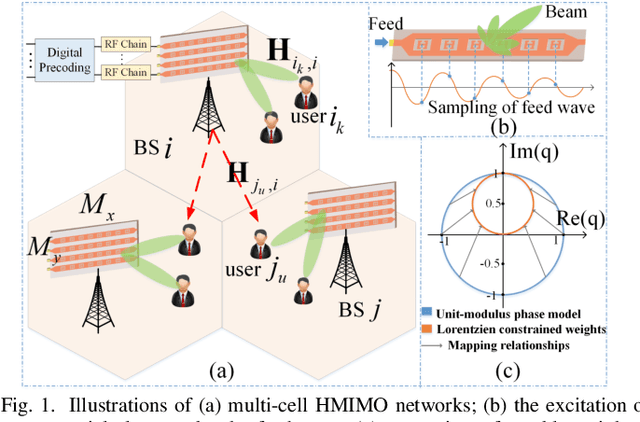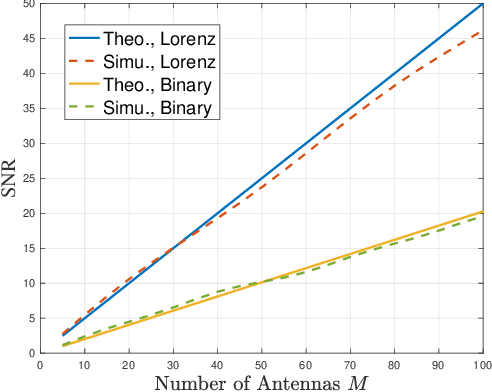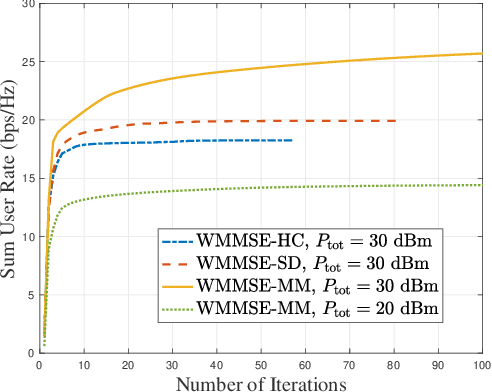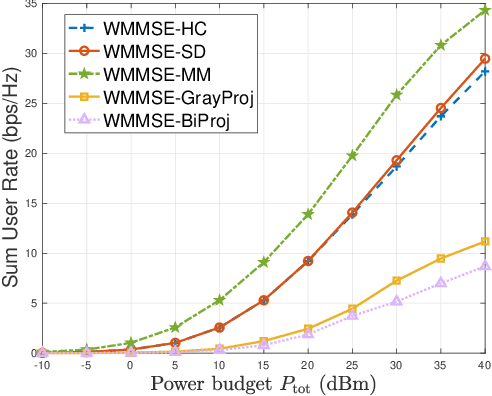Tianyu Yang
Alibaba DAMO Academy
Near-Field Integrated Imaging and Communication in Distributed MIMO Networks
Aug 24, 2025Abstract:In this work, we propose a general framework for wireless imaging in distributed MIMO wideband communication systems, considering multi-view non-isotropic targets and near-field propagation effects. For indoor scenarios where the objective is to image small-scale objects with high resolution, we propose a range migration algorithm (RMA)-based scheme using three kinds of array architectures: the full array, boundary array, and distributed boundary array. With non-isotropic near-field channels, we establish the Fourier transformation (FT)-based relationship between the imaging reflectivity and the distributed spatial-domain signals and discuss the corresponding theoretical properties. Next, for outdoor scenarios where the objective is to reconstruct the large-scale three-dimensional (3D) environment with coarse resolution, we propose a sparse Bayesian learning (SBL)-based algorithm to solve the multiple measurement vector (MMV) problem, which further addresses the non-isotropic reflectivity across different subcarriers. Numerical results demonstrate the effectiveness of the proposed algorithms in acquiring high-resolution small objects and accurately reconstructing large-scale environments.
LlamaSeg: Image Segmentation via Autoregressive Mask Generation
May 26, 2025Abstract:We present LlamaSeg, a visual autoregressive framework that unifies multiple image segmentation tasks via natural language instructions. We reformulate image segmentation as a visual generation problem, representing masks as "visual" tokens and employing a LLaMA-style Transformer to predict them directly from image inputs. By adhering to the next-token prediction paradigm, our approach naturally integrates segmentation tasks into autoregressive architectures. To support large-scale training, we introduce a data annotation pipeline and construct the SA-OVRS dataset, which contains 2M segmentation masks annotated with over 5,800 open-vocabulary labels or diverse textual descriptions, covering a wide spectrum of real-world scenarios. This enables our model to localize objects in images based on text prompts and to generate fine-grained masks. To more accurately evaluate the quality of masks produced by visual generative models, we further propose a composite metric that combines Intersection over Union (IoU) with Average Hausdorff Distance (AHD), offering a more precise assessment of contour fidelity. Experimental results demonstrate that our method surpasses existing generative models across multiple datasets and yields more detailed segmentation masks.
ReEx-SQL: Reasoning with Execution-Aware Reinforcement Learning for Text-to-SQL
May 19, 2025Abstract:In Text-to-SQL, execution feedback is essential for guiding large language models (LLMs) to reason accurately and generate reliable SQL queries. However, existing methods treat execution feedback solely as a post-hoc signal for correction or selection, failing to integrate it into the generation process. This limitation hinders their ability to address reasoning errors as they occur, ultimately reducing query accuracy and robustness. To address this issue, we propose ReEx-SQL (Reasoning with Execution-Aware Reinforcement Learning), a framework for Text-to-SQL that enables models to interact with the database during decoding and dynamically adjust their reasoning based on execution feedback. ReEx-SQL introduces an execution-aware reasoning paradigm that interleaves intermediate SQL execution into reasoning paths, facilitating context-sensitive revisions. It achieves this through structured prompts with markup tags and a stepwise rollout strategy that integrates execution feedback into each stage of generation. To supervise policy learning, we develop a composite reward function that includes an exploration reward, explicitly encouraging effective database interaction. Additionally, ReEx-SQL adopts a tree-based decoding strategy to support exploratory reasoning, enabling dynamic expansion of alternative reasoning paths. Notably, ReEx-SQL achieves 88.8% on Spider and 64.9% on BIRD at the 7B scale, surpassing the standard reasoning baseline by 2.7% and 2.6%, respectively. It also shows robustness, achieving 85.2% on Spider-Realistic with leading performance. In addition, its tree-structured decoding improves efficiency and performance over linear decoding, reducing inference time by 51.9% on the BIRD development set.
Holographic MIMO Multi-Cell Communications
Feb 23, 2025



Abstract:Metamaterial antennas are appealing for next-generation wireless networks due to their simplified hardware and much-reduced size, power, and cost. This paper investigates the holographic multiple-input multiple-output (HMIMO)-aided multi-cell systems with practical per-radio frequency (RF) chain power constraints. With multiple antennas at both base stations (BSs) and users, we design the baseband digital precoder and the tuning response of HMIMO metamaterial elements to maximize the weighted sum user rate. Specifically, under the framework of block coordinate descent (BCD) and weighted minimum mean square error (WMMSE) techniques, we derive the low-complexity closed-form solution for baseband precoder without requiring bisection search and matrix inversion. Then, for the design of HMIMO metamaterial elements under binary tuning constraints, we first propose a low-complexity suboptimal algorithm with closed-form solutions by exploiting the hidden convexity (HC) in the quadratic problem and then further propose an accelerated sphere decoding (SD)-based algorithm which yields global optimal solution in the iteration. For HMIMO metamaterial element design under the Lorentzian-constrained phase model, we propose a maximization-minorization (MM) algorithm with closed-form solutions at each iteration step. Furthermore, in a simplified multiple-input single-output (MISO) scenario, we derive the scaling law of downlink single-to-noise (SNR) for HMIMO with binary and Lorentzian tuning constraints and theoretically compare it with conventional fully digital/hybrid arrays. Simulation results demonstrate the effectiveness of our algorithms compared to benchmarks and the benefits of HMIMO compared to conventional arrays.
Beyond Single-Value Metrics: Evaluating and Enhancing LLM Unlearning with Cognitive Diagnosis
Feb 19, 2025Abstract:Due to the widespread use of LLMs and the rising critical ethical and safety concerns, LLM unlearning methods have been developed to remove harmful knowledge and undesirable capabilities. In this context, evaluations are mostly based on single-value metrics such as QA accuracy. However, these metrics often fail to capture the nuanced retention of harmful knowledge components, making it difficult to assess the true effectiveness of unlearning. To address this issue, we propose UNCD (UNlearning evaluation via Cognitive Diagnosis), a novel framework that leverages Cognitive Diagnosis Modeling for fine-grained evaluation of LLM unlearning. Our dedicated benchmark, UNCD-Cyber, provides a detailed assessment of the removal of dangerous capabilities. Moreover, we introduce UNCD-Agent, which refines unlearning by diagnosing knowledge remnants and generating targeted unlearning data. Extensive experiments across eight unlearning methods and two base models demonstrate that UNCD not only enhances evaluation but also effectively facilitates the removal of harmful LLM abilities.
CLIPErase: Efficient Unlearning of Visual-Textual Associations in CLIP
Oct 30, 2024



Abstract:Machine unlearning (MU) has gained significant attention as a means to remove specific data from trained models without requiring a full retraining process. While progress has been made in unimodal domains like text and image classification, unlearning in multimodal models remains relatively underexplored. In this work, we address the unique challenges of unlearning in CLIP, a prominent multimodal model that aligns visual and textual representations. We introduce CLIPErase, a novel approach that disentangles and selectively forgets both visual and textual associations, ensuring that unlearning does not compromise model performance. CLIPErase consists of three key modules: a Forgetting Module that disrupts the associations in the forget set, a Retention Module that preserves performance on the retain set, and a Consistency Module that maintains consistency with the original model. Extensive experiments on the CIFAR-100 and Flickr30K datasets across four CLIP downstream tasks demonstrate that CLIPErase effectively forgets designated associations in zero-shot tasks for multimodal samples, while preserving the model's performance on the retain set after unlearning.
Cooperative Multistatic Target Detection in Cell-Free Communication Networks
Oct 21, 2024


Abstract:In this work, we consider the target detection problem in a multistatic integrated sensing and communication (ISAC) scenario characterized by the cell-free MIMO communication network deployment, where multiple radio units (RUs) in the network cooperate with each other for the sensing task. By exploiting the angle resolution from multiple arrays deployed in the network and the delay resolution from the communication signals, i.e., orthogonal frequency division multiplexing (OFDM) signals, we formulate a cooperative sensing problem with coherent data fusion of multiple RUs' observations and propose a sparse Bayesian learning (SBL)-based method, where the global coordinates of target locations are directly detected. Intensive numerical results indicate promising target detection performance of the proposed SBL-based method. Additionally, a theoretical analysis of the considered cooperative multistatic sensing task is provided using the pairwise error probability (PEP) analysis, which can be used to provide design insights, e.g., illumination and beam patterns, for the considered problem.
Robust Utility-Preserving Text Anonymization Based on Large Language Models
Jul 16, 2024Abstract:Text anonymization is crucial for sharing sensitive data while maintaining privacy. Existing techniques face the emerging challenges of re-identification attack ability of Large Language Models (LLMs), which have shown advanced capability in memorizing detailed information and patterns as well as connecting disparate pieces of information. In defending against LLM-based re-identification attacks, anonymization could jeopardize the utility of the resulting anonymized data in downstream tasks -- the trade-off between privacy and data utility requires deeper understanding within the context of LLMs. This paper proposes a framework composed of three LLM-based components -- a privacy evaluator, a utility evaluator, and an optimization component, which work collaboratively to perform anonymization. To provide a practical model for large-scale and real-time environments, we distill the anonymization capabilities into a lightweight model using Direct Preference Optimization (DPO). Extensive experiments demonstrate that the proposed models outperform baseline models, showing robustness in reducing the risk of re-identification while preserving greater data utility in downstream tasks. Our code and dataset are available at https://github.com/UKPLab/arxiv2024-rupta.
SymPoint Revolutionized: Boosting Panoptic Symbol Spotting with Layer Feature Enhancement
Jul 02, 2024Abstract:SymPoint is an initial attempt that utilizes point set representation to solve the panoptic symbol spotting task on CAD drawing. Despite its considerable success, it overlooks graphical layer information and suffers from prohibitively slow training convergence. To tackle this issue, we introduce SymPoint-V2, a robust and efficient solution featuring novel, streamlined designs that overcome these limitations. In particular, we first propose a Layer Feature-Enhanced module (LFE) to encode the graphical layer information into the primitive feature, which significantly boosts the performance. We also design a Position-Guided Training (PGT) method to make it easier to learn, which accelerates the convergence of the model in the early stages and further promotes performance. Extensive experiments show that our model achieves better performance and faster convergence than its predecessor SymPoint on the public benchmark. Our code and trained models are available at https://github.com/nicehuster/SymPointV2.
Compress3D: a Compressed Latent Space for 3D Generation from a Single Image
Mar 20, 2024Abstract:3D generation has witnessed significant advancements, yet efficiently producing high-quality 3D assets from a single image remains challenging. In this paper, we present a triplane autoencoder, which encodes 3D models into a compact triplane latent space to effectively compress both the 3D geometry and texture information. Within the autoencoder framework, we introduce a 3D-aware cross-attention mechanism, which utilizes low-resolution latent representations to query features from a high-resolution 3D feature volume, thereby enhancing the representation capacity of the latent space. Subsequently, we train a diffusion model on this refined latent space. In contrast to solely relying on image embedding for 3D generation, our proposed method advocates for the simultaneous utilization of both image embedding and shape embedding as conditions. Specifically, the shape embedding is estimated via a diffusion prior model conditioned on the image embedding. Through comprehensive experiments, we demonstrate that our method outperforms state-of-the-art algorithms, achieving superior performance while requiring less training data and time. Our approach enables the generation of high-quality 3D assets in merely 7 seconds on a single A100 GPU.
 Add to Chrome
Add to Chrome Add to Firefox
Add to Firefox Add to Edge
Add to Edge